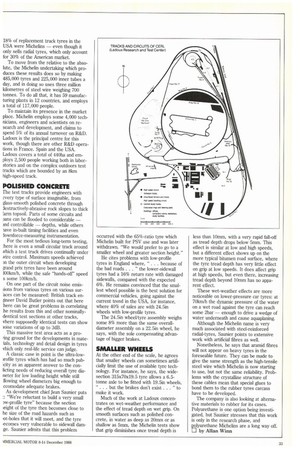18% of replacement truck tyres in the USA were Michelins
Page 55

If you've noticed an error in this article please click here to report it so we can fix it.
— even though it only sells radial tyres, which only account for 30% of the American market.
To move from the relative to the absolute, the Michelin undertaking which produces these results does so by making 485,000 tyres and 225,000 inner tubes a day, and in doing so uses three million kilometres of steel wire weighing 700 tonnes. To do all that, it has 59 manufacturing plants in 12 countries, and employs a total of 117,000 people.
To maintain its presence in the market place. Michelin employs some 4,000 technicians, engineers and scientists on research and development, and claims to spend 5% of its annual turnover on R&D. Ladoux is the principal centre for this work, though there are other R&D operations in France. Spain and the USA. Ladoux covers a total of 440ha and employs 2,500 people working both in laboratories and on the complex outdoors test tracks which are bounded by an 8km high-speed track.
POLISHED CONCRETE
The test tracks provide engineers with every type of surface imaginable, from glass-smooth polished concrete through lestructively-abrasive rock slopes to thick farm topsoil. Parts of some circuits and 3ans can be flooded to considerable — Ind controllable — depths, while others -lave in-built timing facilities and even lownforce-measuring instrumentation.
For the most tedious long-term testing, -here is even a small circular track around which a test truck drives continually under mire control. Maximum speeds achieved mfl the outer circuit when developing rand prix tyres have been around 300km/h, while the safe "hands-off' speed s some 100km/h.
On one part of the circuit noise emisions from various tyres on various suraces can be measured: British track enOneer David Butler points out that here here can be great problems in correlating he results from this and other nominallydentical test sections at other tracks, vhere supposedly identical tests can show ioise variations of up to 3dB.
This massive test area acts as a proring ground for the developments in mateials, technology and detail design in tyres which only real-life service can judge. A classic case in point is the ultra-lowirofile tyres which has had so much pub:city as an apparent answer to the conlicting needs of reducing overall tyre dianeter for low loading height while still llowing wheel diameters big enough to ccomodate adequate brakes.
As development chief Jean Saunier puts "We're reluctant to build a very small )w-profile tyre" because the section eight of the tyre then becomes close to he size of the road hazards such as ot-holes that it will meet, and the tyre ecomes very vulnerable to sidewall damge. Saunier admits that this problem occurred with the 65%-ratio tyre which Michelin built for PSV use and was later withdrawn. "We would prefer to go to a smaller wheel and greater section height."
He cites problems with low-profile tyres in England where, " . . . because of the bad roads. . . "the lower-sidewall tyres had a 16% return rate with damaged sidewalls, compared with the expected 6%. He remains convinced that the smallest wheel possible is the best solution for commercial vehicles, going against the current trend in the USA, for instance, where 40% of sales are with 24.5in wheels with low-profile tyres.
The 24.5in wheel/tyre assembly weighs some 8% more than the same overalldiameter assembly on a 22.5in wheel, he says, with the sole compensating advantage of bigger brakes.
SMALLER WHEELS
At the other end of the scale, he agrees that smaller wheels can sometimes artificially limit the use of available tyre technology. For instance, he says, the widesection 315x70x19.5 tyre allows a 6.5tonne axle to be fitted with 19. 5th wheels, " . . . but the brakes don't exist. . "to make it work.
Much of the work at Ladoux concentrates on wet-weather performance and the effect of tread depth on wet grip. On smooth surfaces such as polished concrete, in water as deep as 20mm or as shallow as 5flun, the Michelin tests show that grip diminishes once tread depth is less than lOmm, with a very rapid fall-off as tread depth drops below 5rnin. This effect is similar at low and high speeds, but a different effect shows up on the more typical bitumen road surface, where the tyre tread depth has very little effect on grip at low speeds. It does affect grip at high speeds, but even there, increasing tread depth beyond 10mm has no apparent effect.
These wet-weather effects are more noticeable on lower-pressure car tyres: at 70km/h the dynamic pressure of the water on a wet road against the tyre can reach some 2bar — enough to drive a wedge of water underneath and cause aquaplaning.
Although the Michelin name is very much associated with steel-reinforced radial-tyres, Saunier points to extensive work with artificial fibres as well.
Nonetheless, he says that aramid fibres will not appear on heavy tyres in the foreseable future. They can be made to give the same strength as the high-tensile steel wire which Michelin is now starting to use, but not the same reliability. Problems with the crystalline structure of these cables mean that special glues to bond them to the rubber tyres carcass have to be developed.
The company is also looking at alternative materials to rubber for its cases. Polyurethane is one option being investigated, but Saunier stresses that this work is only in the research phase, and E1yurethane Michelins are a long way off. Ul by Allan Winn


















































































